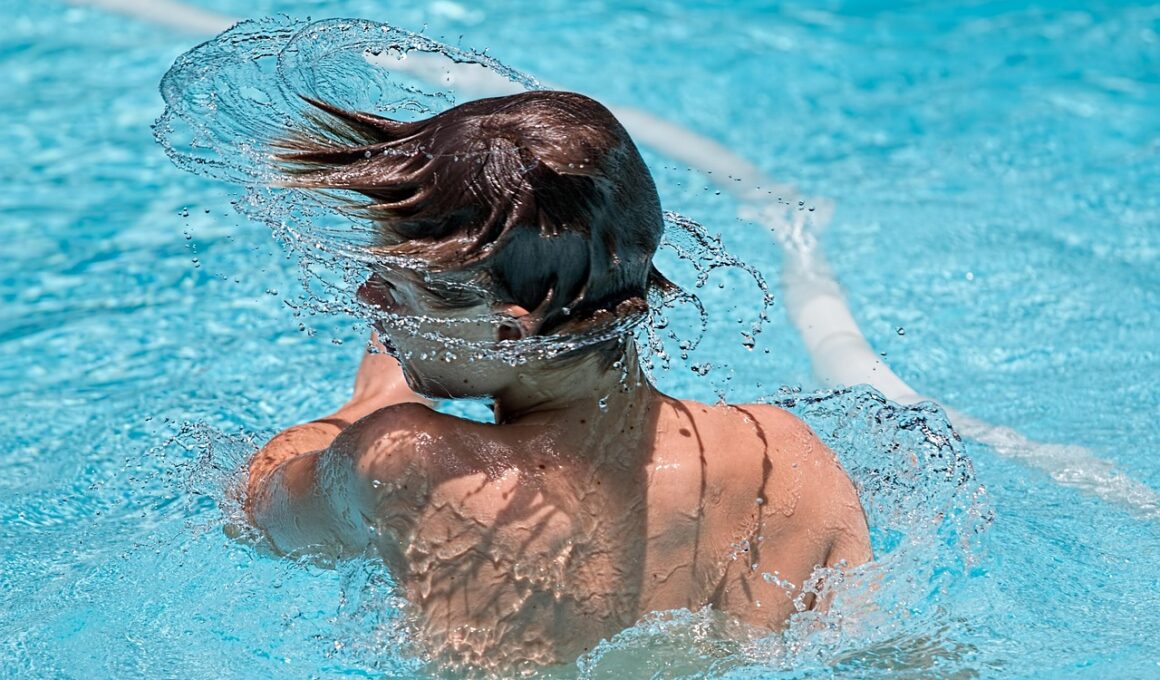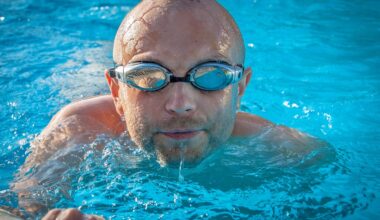How Swimming Can Aid Mental and Physical Wellness in Eating Disorder Recovery
Swimming is not just a sport of leisure; it provides numerous benefits particularly in the context of recovery from eating disorders. Individuals suffering from these disorders often experience intense anxiety and stress, which can hinder their recovery process. Engaging in swimming can improve mental clarity and enhance mood due to the release of endorphins. When someone swims, the rhythmic strokes promote relaxation while also distracting from negative thoughts and compulsive behaviors. Moreover, the buoyancy of water allows individuals to move without the burden of their body’s weight, making exercise feel less daunting and more enjoyable. Several studies have shown that physical activity leads to increased self-esteem, offering an opportunity for personal achievement. As a result, participating in swimming could foster a sense of accomplishment, encouraging individuals to adhere to their recovery goals. The social aspect of swimming in groups can also create a supportive community that individuals can lean on during challenging times. Positive reinforcement from peers can significantly influence one’s mental state as they navigate through recovery, making swimming a comprehensive tool for mental and physical wellness.
The Physical Benefits of Swimming
Beyond mental health, swimming provides significant physical benefits that are essential for those recovering from eating disorders. Many individuals may have dealt with malnourishment or disordered eating patterns that affect their physical capabilities. Swimming is a low-impact activity that is easy on the joints and suitable for all fitness levels. It aids in cardiovascular health, increasing stamina and endurance without putting excessive strain on the body. Additionally, swimming improves muscle tone by engaging various muscle groups, promoting overall strength. Individuals may also find swimming helps improve their flexibility, as the water allows for a greater range of motion compared to land exercises. Regular practice can boost metabolism, which is particularly beneficial if individuals are working towards normalizing their eating habits. Importantly, swimming encourages the body to find a natural rhythm, which can be therapeutic for those on the path to recovery. As a holistic form of exercise, swimming fosters a healthy relationship with the body, helping to refocus attention from outward appearances to inner sensations and overall well-being.
The calming effects of water can be a powerful component of mental healing. Swimming promotes mindfulness, allowing individuals to focus deeply on the sensations of the water against their skin and their breath as it synchronizes with movement. This sense of awareness can be particularly crucial in overcoming negative body image, which is often a major hurdle in eating disorder recovery. Instead of judging their physical appearance, individuals can learn to appreciate their body’s capabilities and functions through swimming. The act of gliding through water can symbolize progress, resilience, and new beginnings. Additionally, swimming encourages individuals to practice deep breathing, which has known benefits for reducing anxiety and stress. As swimmers’ hearts adapt to the demands of the workout, they may notice improved circulation and oxygen flow throughout their bodies, enhancing both physical and mental vitality. On a psychological level, the repetitive nature of swimming can provide comfort and routine, essential elements in recovery. Swimmers can establish rituals, like favorite playlists or strokes, that give a sense of control and predictability amid the chaos that often accompanies eating disorders.
Community and Connection Through Swimming
Swimming not only serves as a personal journey but also fosters community and connection, crucial aspects of recovery for individuals facing eating disorders. Group swimming sessions can create a sense of belonging and mutual understanding among participants. Finding friends or peers who share similar struggles can significantly ease feelings of isolation. Engaging in a shared activity promotes camaraderie and encourages participants to celebrate each other’s achievements. This mutual support system can create meaningful connections that reinforce recovery goals. Furthermore, swimming clubs or classes can provide structured environments, which are beneficial for individuals needing routine. In these settings, members can challenge each other in a positive way while setting and achieving goals together. Studies indicate that social support is vital in recovery, as it can improve resilience against setbacks. Social interaction within the water creates a unique bond, where individuals can feel liberated from societal pressures regarding body image and appearance. As friendships develop, individuals may find an enhanced sense of responsibility towards their peers, motivating them to stay on the path of healing.
Incorporating swimming into a wellness routine is not only a commitment to physical fitness; it can be life-changing for mental health. Mindfulness is an essential tool in overcoming eating disorders, and swimming promotes this practice naturally. Individuals learn to stay present amidst uncertainty instead of resorting to negative coping mechanisms. As swimmers develop new skills, they may start to believe in their ability to achieve recovery. Over time, this can alter negative self-perceptions, allowing room for self-compassion and acceptance. The lightness felt while in the water mirrors the release of burdens associated with disordered eating patterns. Furthermore, individuals may discover new strengths they did not know they possessed, boosting confidence in everyday life. Regular engagement in swimming provides a constructive outlet for emotions that might otherwise lead to unhealthy behaviors. This positive reinforcement can nourish mental resilience, encouraging individuals to confront their challenges more boldly. As they relearn to trust their bodies and embrace healthy living, the journey towards recovery becomes clearer and more achievable, driven by newfound hope and inspiration.
Setting Healthy Goals Through Swimming
Acknowledging personal goals is vital in the recovery process, and swimming offers a platform for setting both short-term and long-term aspirations. Individuals can learn to set realistic swim targets, such as improving endurance, speed, or mastering different strokes. This goal-oriented approach channels energy into trackable accomplishments rather than focusing solely on weight or diet. By celebrating milestones in swimming, individuals can build a more positive mindset towards overall health. Furthermore, these skills foster a sense of achievement, teaching individuals that they are capable of improving through hard work and effort. Recognizing progress is essential in combatting feelings of failure or despair often linked to eating disorders. As swimmers proceed through their targets, they gain motivation and courage to set even higher aspirations. This continuous cycle of establishing and surpassing goals creates a sense of purpose that enhances self-worth. By connecting personal achievements with broader wellness objectives, swimming becomes a constructive engagement fostering both physical and mental health. Swimming can cultivate a recovery vocabulary that reflects each individual’s journey, reinforcing their self-belief in recovery.”},{
Ultimately, swimming provides critical benefits that enhance the overall recovery from eating disorders. By actively engaging in this form of exercise, individuals can transform their relationships with their bodies, enhance their physical fitness, and improve their mental wellness. The feelings of accomplishment gained through swimming can translate into broader aspects of life, impacting personal, social, and emotional dimensions positively. As communities come together in shared enjoyment of water, the stigma surrounding eating disorders can be challenged and reduced. Individuals can learn that recovery is a journey, not a destination, where each swim represents a step forward in rediscovering health and happiness. Furthermore, swimming allows individuals to develop resilience by facing challenges head-on in a safe and nurturing environment. The water speaks to a deep-seated need for human connection and self-love that resonates with everyone at some level. By combining the emotional and physical benefits of swimming, a comprehensive pathway towards recovery is established, marked by hope and solidarity. Thus, swimming emerges as a valuable tool in navigating the complexities of eating disorder recovery.
In conclusion, the significance of swimming in aiding recovery from eating disorders cannot be overstated. It emerges as both a therapeutic exercise and a calming practice that empowers individuals to heal holistically. The act of swimming fosters an environment for self-exploration, community engagement, and emotional growth that enriches lives deeply. By immersing oneself in water, individuals can develop healthier coping mechanisms and liberate themselves from destructive thoughts. In recognizing that wellness encompasses physical, emotional, and community dimensions, swimming aligns perfectly with the needs of individuals recovering from eating disorders. As the journey toward recovery continues, swimming provides an adaptable framework where progress can be gauged on a personal level. Individuals emerge from the water with renewed vitality, resilience, and a sense of achievement. Ultimately, swimming transcends mere physical activity; it becomes a powerful metaphor for growth and transformation while reinforcing the principle that recovery is indeed attainable. Through consistent practice, support, and dedication, individuals can find solace and strength as they progress in their journeys towards mental and physical wellness.


